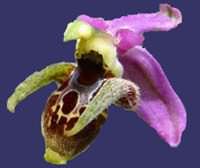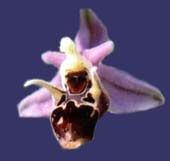 |
ΕΛΛΗΝΙΚΕΣ ΚΕΡΑΣΦΟΡΕΣ ΟΡΧΙΔΕΕΣ ΤΟΥ ΓΕΝΟΥΣ OPHRYS Greek Ophrys with long side horns |
 |
ΕΛΛΗΝΙΚΕΣ ΚΕΡΑΣΦΟΡΕΣ ΟΡΧΙΔΕΕΣ ΤΟΥ ΓΕΝΟΥΣ OPHRYS Greek Ophrys with long side horns |
Εισαγωγή
Η Ελλάδα κατατάσσεται στα μέρη που έχουν εκτενώς εξερευνηθεί από μελετητές Ορχιδέων τα τελευταία 80 έτη. Ωστόσο, υπήρχε όλα αυτά τα χρόνια, η εντύπωση ότι η ονοματολογία ορισμένων μελών της ομάδας scolopax του γένους Ophrys ήταν λανθασμένη και παρωχημένη. Γενικά, φυτά της ομάδας αυτής από την ηπειρωτική χώρα, χωριζόταν αδρά σε τέσσερα είδη, λαμβάνοντας υπόψη κυρίως το μήκος του χείλους και των πλαϊνών λοβών, συγκεκριμένα τις Ophrys cornuta, bicornis, bremifera και heldreichii, χωρίς να υπολογίζονται άλλα σημαντικά στοιχεία ταυτοποίησης, όπως πιθανοί επικονιαστές, αναλογίες μεταξύ διαφόρων μερών του άνθους, προτιμήσεις σε βιότοπους, ημερομηνίες άνθησης, κλπ. Στα νησιά, λεπτομερέστερες μελέτες οδήγησαν τα τελευταία χρόνια στην αναγνώριση "σταθερών" ειδών, μορφολογικά ξεχωριστών, όπως η Ophrys minutula από την Λέσβο, η Ophrys leptomera από την Εύβοια και οι Ophrys dodekanensis και Ophrys cornutula από την Ρόδο.
Μέσα σε όλα αυτά τα είδη ξεχωρίζει το σύμπλεγμα bicornis-cornuta με τους χαρακτηριστικούς πλαϊνούς λοβούς των ανθών, που έχουν το σχήμα μακριών κεράτων. Από την in situ παρατήρηση των φυτών του συμπλέγματος αυτού, υπάρχει η γενικότερη αίσθηση ότι είναι ιδιαίτερα ανομοιογενές και αποτελείται από περισσότερα από 2 είδη, με μεγάλες διακυμάνσεις στο μήκος του χείλους (από 6 ως 16mm), μεγάλη ποικιλομορφία στην κατεύθυνση, δομή και μήκος των πλαϊνών λοβών, στην εγκάρσια κυρτότητα του χείλους και στο μήκος και πυκνότητα των τριχιδίων στο περιθώριο του κεντρικού λοβού (για παράδειγμα, δείτε την αναφορά στην Ophrys cornuta var. minuscula, από τους G. & W.Thiele, 2002 στην σελίδα "OPHRYS NEWS 2").
Η μεγάλη αυτή ποικιλομορφία οδήγησε σε σύγχυση στην ταξινόμηση των κερασφόρων αυτών Ophrys και γενικότερα της ομάδας scolopax, στην υιοθέτηση διαφορετικών ονομάτων από διακεκριμένους μελετητές (γίνεται σύντομη αναφορά αυτής της ποικιλίας ονομασιών, επίσης στην σελίδα "OPHRYS NEWS 2") και στον αυθαίρετο προσδιορισμό φυτών, με χαρακτηριστικό παράδειγμα την αναφορά στην ύπαρξη της Ophrys scolopax σε νησιά των Κυκλάδων, ενός είδους της δυτικής Μεσογείου και την εμπειρική ονομασία όλων των φυτών με κοντούς πλαϊνούς λοβούς, ως Ophrys bremifera.
Νεότερη ονοματολογία
Οι P. Devillers και J. Devillers-Terschuren στο πολύ πρόσφατο και αποκαλυπτικό τους άρθρο με τίτλο "Scolopaxoid Ophrys of the Adriatic. Diversity and biogeographical context" (La Section Orchidées d'Europe des Naturalistes belges., hors-série 2004, 85 - Spécial Orchidées n°17: 188-234), (βλ. επίσης στα LINKS & LITERATURE) παρουσιάζοντας τα αποτελέσματα πολυετούς μελέτης δειγμάτων συλλογών, φωτογραφικού υλικού και φυσικών πληθυσμών, προσπάθησαν να επιλύσουν τα προβλήματα ταυτοποίησης και να προσδιορίσουν ακριβέστερα την παρούσα κατάσταση των φυτών της ομάδας scolopax στην ανατολική Μεσόγειο, καταλήγοντας σε αναγνώριση αρκετών νέων ειδών και ομάδων και σε ανακατανομή των διαφόρων ειδών μέσα στις υπάρχουσες ομάδες.
Με πειστικά στοιχεία, χρήση κυρίως βιογεωγραφικών κριτηρίων διαχωρισμού και καταγραφή μετρήσεων και αναλογιών μεταξύ διαφόρων τμημάτων του άνθους και λαμβάνοντας υπόψη την μεγάλη ποικιλομορφία ορισμένων χαρακτηριστικών όπως του μήκους των πλαϊνών κεράτων και της πλαϊνής τριχοφυΐας των χειλών, μελετούν ως ολότητα τις Ophrys των παλαιών ομάδων scolopax, bornmuelleri, και tetraloniae. Έτσι καταλήγουν στην περιγραφή 2 νέων ομάδων με ανακατανομή των ειδών μέσα σε αυτές και εντάσσουν όλες τις κερασφόρες Ophrys της Ελλάδας στην νέα ομάδα oestrifera. Σύμφωνα με τους συγγραφείς, η Ophrys cornuta δεν υπάρχει στην Ελλάδα, η Ophrys bicornis πιθανά υπάρχει μόνο στο Βόρειο Αιγαίο και την Θράκη και αντί αυτών περιγράφουν τα παρακάτω νέα είδη, που ανήκουν όλα στην νέα ομάδα oestrifera:
| Ophrys sepioides | |
| Ophrys schlechteriana | |
| Ophrys crassicornis | |
| Ophrys cerastes (που πιθανά αποτελείται από περισσότερα του ενός, διαφορετικά είδη) |
Παρουσίαση κερασφόρων Ophrys
Μετά τις πρόσφατες αυτέ εξελίξεις θα είχε ιδιαίτερο ενδιαφέρον η παρουσίαση φωτογραφικού υλικού κυρίως από την ηπειρωτική Ελλάδα. Λόγω της μεγάλης ετερογένειας των ειδών της ομάδας oestrifera, θα γίνει απλή παρουσίασή των φυτών, με παράλληλη καταγραφή ορισμένων σχολίων και μετρήσεων των τμημάτων του άνθους, όταν υπάρχουν.
Η ταξινόμηση των κερασφόρων Ophrys που θα παρουσιαστούν θα γίνει μόνο με κριτήριο γεωγραφικής κατανομής και θα τοποθετούνται ξεχωριστά πληθυσμοί απομακρυσμένοι ή γεωφυσικά απομονωμένοι (π.χ. πληθυσμοί νησιών). Παράλληλα θα αναφέρονται το είδος του βιότοπου και η παρουσία άλλων ειδών στο ίδιο ενδιαίτημα. Η αντίστοιχη σελίδα με τις λεπτομέρειες και το φωτογραφικό υλικό ανοίγει με τις συνδέσεις του παρακάτω πίνακα:
 |
Πλαγιές βόρειου Ολύμπου, Πιέρια και Βέρμιο (κεντρική Μακεδονία) (16 διαφάνειες) (διαθέσιμο και ως slide show) (χάρτης κατανομής) |
 |
Ζαγοροχώρια (Ήπειρος) (11 διαφάνειες) (διαθέσιμο και ως slide show) (χάρτης κατανομής) |
 |
Θάσος (βόρειο Αιγαίο) (10 διαφάνειες) (διαθέσιμο και ως slide show) (χάρτης κατανομής) |
 |
Πάικο και Βόρρας (κεντρική Μακεδονία) (15 διαφάνειες) (διαθέσιμο και ως slide show) (χάρτης κατανομής) |
 |
Κοζάνη, Γρεβενά και Καστοριά (7 διαφάνειες) |
 |
Θράκη (4 διαφάνειες) |
 |
Πλαγιές νότιου Ολύμπου (4 διαφάνειες) |
 |
Λέσβος (8 διαφάνειες) |
 |
Στερεά Ελλάδα και Πελοπόννησος (13 διαφάνειες) |
![]()
Greece is one of the places that have been explored extensively by Orchids researchers, the last 80 years. However, all these years, there was an impression that the nomenclature of certain members of the scolopax group, in the Ophrys genus was erroneous and old. Generally, plants of this group from the continental country, was separated profusely in four species, taking into consideration the length of the lip and the lateral lobes and without estimating other important elements of identification, as the possible pollinators, proportions between various parts of the flowers, preferences in biotopes, flowering times, etc. These 4 species were named Ophrys cornuta, bicornis, bremifera and heldreichii. Only in the islands, detailed studies during the last years, lead to the recognition of “stable” species, morphologically separate, with best paradigms, the Ophrys minutula from Lesvos, Ophrys leptomera from Euboia and Ophrys dodekanensis and Ophrys cornutula from Rhodes.
Among all these species, the bicornis-cornuta complex is clearly distinctive with the characteristic lateral lobes of the lip, which have the appearance of long horns. In situ observations of this complex, are responsible for the general sense that it is particularly non-homogeneous and constituted by more than 2 species, with big fluctuations in the lip length (from 6 as 16mm) and enormous variability in the direction, structure and length of lateral lobes, lip transversal convexity and median lobe pilosity (for example, you may see the reference about the Ophrys cornuta var. minuscula, by G. and W.Thiele, 2002, in the page "OPHRYS NEWS 2").
This big diversity resulted to the misleading classification of these long horned Ophrys of the scolopax group, the adoption of different names by important orchid researchers (a short report of this confusion in names, can be found also in the page "OPHRYS NEWS 2") and the arbitrary determination of plants, with characteristic examples the reference that Ophrys scolopax, a western Mediterranean species, exists in Cyclades islands and the empiric determination of all plants with short lateral lobes, as Ophrys bremifera.
New nomenclature
P. Devillers and J. Devillers-Terschuren in their very recent and revealing article, with the title "Scolopaxoid Ophrys of the Adriatic. Diversity and biogeographical context" (La Section Orchidées d'Europe des Naturalistes belges., hors-série 2004, 85 - Spécial Orchidées n°17: 188-234), (see also in LINKS & LITERATURE) presented the results of their multiannual study of herbarium samples, photographic material and natural populations. In this way, they tried to solve the identification problems and determine more precisely the present status of plants of the scolopax group, in the Eastern Mediterranean. The result was the recognition of many new species and groups and the reallocation of various species in the existing groups.
With convincing evidence, use of biogeographic criteria of segregation, recording of measurements and proportions between various flower parts and taking into consideration the great diversity of certain characteristics as the length of the side horns and the distribution and density of the lip pilosity, they studied the Ophrys of older scolopax, bornmuelleri, and tetraloniae groups, as an entity. Thus they concluded to the description of 2 new groups with reallocation of species in them and they included all the long horned Ophrys of Greece in the new oestrifera group. According to the writers, Ophrys cornuta does not exist in Greece, Ophrys bicornis probably is distributed only in the Northern Aegean and Thrace and instead of them, they describe the following new species, all belonging to the new oestrifera group:
| Ophrys sepioides | |
| Ophrys schlechteriana | |
| Ophrys crassicornis | |
| Ophrys cerastes (polytypic, probably representing more than one species) |
Presentation of Ophrys with long side horns
Under the light of these recent announcements, presentation of photographic material mainly from continental Greece would have particular interest. The Ophrys of the newly described oestrifera group are growing in abundance through Greece and the islands and show heterogeneity in many characteristics. This heterogeneity is apparent even in individuals of the same population. For this reason, the slides will be simply presented, accompanied by some comments and measurements of flower parts, when they are available.
The classification of the presented Ophrys with long horn-shaped lateral lobes, will follow only criteria of geographic distribution while remote populations or geophysically isolated (eg populations of islands), will be described separately. At the same time, the type of biotope and the presence of other species in the same habitat will be reported. The corresponding pages, with details and photographic exhibition open by following the links of the next table:
 |
North Olympos slopes, Pieria range, Vermion (central Macedonia) (16 slides) (available also as a slide show) (distribution map) |
 |
Zagori villages (Epiros) (11 slides) (available also as a slide show) (distribution map) |
 |
Thassos island (north Aegean) (10 slides) (available also as a slide show) (distribution map) |
 |
Paiko and Vorras mountains (central Macedonia) (15 slides) (available also as a slide show) (distribution map) |
 |
Kozani, Grevena and Kastoria (west Macedonia) (7 slides) |
 |
Thrace (4 slides) |
 |
South Olympos slopes (4 slides) |
 |
Lesbos (8 διαφάνειες) |
 |
Sterea Ellada and Peloponnisos (southern Greece) (13 slides) |
back to Greek orchids home
Orchids list - Κατάλογος ορχιδέων